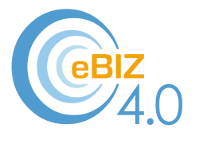|
The aim of this tool is to check the conformance of XML instances to the specification of eBIZ-TCF data models.
-
Upstream (textile clothing footwear) data models: the conformance test is based on reference XML Schema (Moda-ML and Shoenet) plus some business rules represented through co-constraints (Schematron).
-
Downstream data models: the conformance test is based on on reference XML Schema (UBL 2.0) and use profiles of eBIZ (expressed through customised XSDs and Schematrons co-constraints )
Warning: up t0 2013-1, the XML validation is version-sensitive; you should check each document with the right XML Schema for that version; if your document has been built for version 2008-1 you should use the specific validator for that version.
After 2013-1 all the validation is backcompatible: the most recent validator accepts XML documents made with previous versions (not before 2013).
How do you identify the version of the document?
You can check the version of the XML document from the few initial rows (see highlighted text):
|
...
xmlns:ml="http://www.moda-ml.org/moda-ml/repository/schema/v2018-1/TEXOrder.xsd"
…
xsi:schemaLocation="http://www.moda-ml.org/moda-ml/repository/schema/v2018-1/TEXOrder.xsd
http://www.moda-ml.org/moda-ml/repository/schema/v2018-1/TEXOrder.xsd">
...
|
- Validator for eBIZ 2.0 (2013) and eBIZ 4.0 (2018-1),
Explanation about the usage (2013 and 2018) >>
This tool allows checking that a given xml document is conformant to some chosen eBIZ schema, both in structure and content.
The verification process consists of various steps.
-
First, the user is required to choose the area (Textile-Clothing/Footwear, Upstream/Downstream) and run the appropriate validator
-
Second, the user selects the Process/Activity that is implemented through the XML document to be validated (for example: 'Fabric Supply' process, 'Fabric delivery' activity).
-
Third, the user selects the specification (the message type of the XML document, for example 'Textile Despatch Advice')
-
Fourth, the user upload a file containing the xml document to be validated (the only document, without any SOAP or ebXML envelope).
This has to be well formed, which means that the basic XML syntax is respected.
The system will show which are the XML Schema and Schematrons it is going to apply.
-
Fiveth, the user clicks the button 'validate'.
The result is a validation report, specifying either success or failure of the validation.
In the last case, the output contains a list of messages related to all the detected errors and warnings, distinguished in two groups:
-
XML Schema errors, mainly due to structure constraints violations
-
Schematron errors, specifying violations of context constraints (mainly rules taken from the use profile specifications).
Please note that choosing a wrong schema would cause an xml schema error on the first tag of the uploaded document.
-
Validator for previous version, eBIZ 1.0, 2008,
Explanation about the usage (2008) >>
This tool allows checking that a given xml document is conformant to some chosen eBIZ-TCF schema, both in structure and content.
The verification process consists of various steps.
-
First, the user is required to upload a file containing the xml document to be validated (the document alone, not any SOAP or ebXML envelope).
This has to be well formed, which means that the basic XML syntax is respected.
In case of failure, the tool signals a fatal error of well-formedness type, with a message describing the error made.
In case of success, the user is then required to classify the document, according to the available categories (downstream, upstream TC, upstream FW,..etc).
As a consequence, a list of eBiz-TCF Schemas is provided, all belonging to the chosen category (catalogue, order,..).
-
Second, the user selects the XML Schema from that list against which the validation will be made.
-
Third, the user selects the button 'validate'.
The result is a validation report, specifying either success or failure of the validation.
In the last case, the output contains a list of all errors and warnings detected, distinguished in two groups:
-
XML Schema errors, mainly due to structure constraints violations (both violation of generic UBL 2.0 or of the use profile specifications)
-
Schematron errors, specifying violations of context constraints (mainly rules taken from the use profile specifications; only for Downstream documents).
Please note that choosing a wrong schema (wrong type or wrong version) would cause an xml schema error on the first tag of the uploaded document, with the following message:
| 'Cannot find the declaration of element 'ml:xxxxxx' |
.
|
![[PRINT]](/ebiz/images/but_print.gif)
![[PRINT]](/ebiz/images/but_print.gif)







